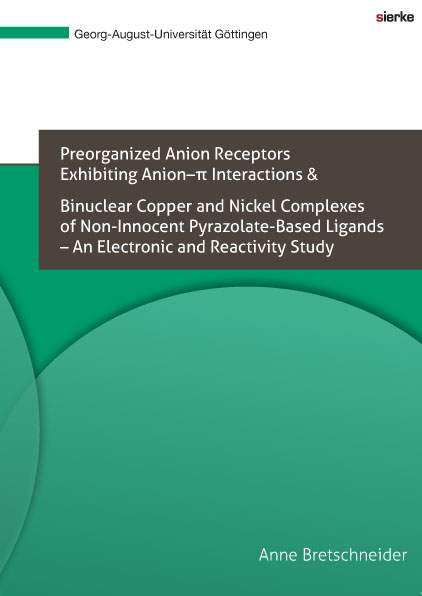Preorganized Anion Receptors Exhibiting Anion−π Interactions &
Binuclear Copper and Nickel Complexes of Non-Innocent Pyrazolate-Based Ligands – An Electronic and Reactivity Study
Seiten
- Keine Verlagsinformationen verfügbar
- Artikel merken
This thesis covers two different areas of chemistry, namely supramolecular and bioinorganic chemistry.
In the first part, the design and application of new receptor molecules developed to bind small mono-nuclear anions via anion–π interactions is introduced. This weak non-covalent interaction was only discovered recently and has been intensely studied since. Herein, two neutral receptor molecules are introduced, displaying either a flexible or a rigid structure. Both receptors were observed to attractively interact with mono-nuclear anions using electron-deficient arene rings as well as an NH hydrogen bond. By conducting spectroscopic and computational analysis on the receptor-anion adducts, further knowledge about the attractive forces in these receptor-anion systems was gained.
Furthermore, the second part focuses on dinuclear metal complexes involving non-innocent ligands. The interplay between the metal center and the ligand is of special interest, as it influences the oxidation behavior of the complex. Herein, an extended salen-type ligand is introduced, which carries the required phenolate residues and is able to coordinate two metal ions in close proximity. Thereby, the complex allows the possibility of concerted reaction pathways including both metal ions. The aim was to determine the locus of oxidation in these systems and to study the influence of electronic modifications on the presented systems.
In the first part, the design and application of new receptor molecules developed to bind small mono-nuclear anions via anion–π interactions is introduced. This weak non-covalent interaction was only discovered recently and has been intensely studied since. Herein, two neutral receptor molecules are introduced, displaying either a flexible or a rigid structure. Both receptors were observed to attractively interact with mono-nuclear anions using electron-deficient arene rings as well as an NH hydrogen bond. By conducting spectroscopic and computational analysis on the receptor-anion adducts, further knowledge about the attractive forces in these receptor-anion systems was gained.
Furthermore, the second part focuses on dinuclear metal complexes involving non-innocent ligands. The interplay between the metal center and the ligand is of special interest, as it influences the oxidation behavior of the complex. Herein, an extended salen-type ligand is introduced, which carries the required phenolate residues and is able to coordinate two metal ions in close proximity. Thereby, the complex allows the possibility of concerted reaction pathways including both metal ions. The aim was to determine the locus of oxidation in these systems and to study the influence of electronic modifications on the presented systems.
| Erscheint lt. Verlag | 1.3.2016 |
|---|---|
| Verlagsort | Göttingen |
| Sprache | englisch |
| Maße | 148 x 210 mm |
| Gewicht | 390 g |
| Einbandart | Paperback |
| Themenwelt | Naturwissenschaften ► Chemie ► Anorganische Chemie |
| Schlagworte | anion-π interaktions • bioinorganic chemistry • charge transfer • metal complexes • non-innocence • Oxidation • perlfluorinated arene • perlfluuorinated arene • receptors • solution studies • supramolecular chemistry |
| ISBN-10 | 3-86844-788-1 / 3868447881 |
| ISBN-13 | 978-3-86844-788-0 / 9783868447880 |
| Zustand | Neuware |
| Haben Sie eine Frage zum Produkt? |
Mehr entdecken
aus dem Bereich
aus dem Bereich
Buch | Hardcover (2024)
Springer Spektrum (Verlag)
CHF 89,95




